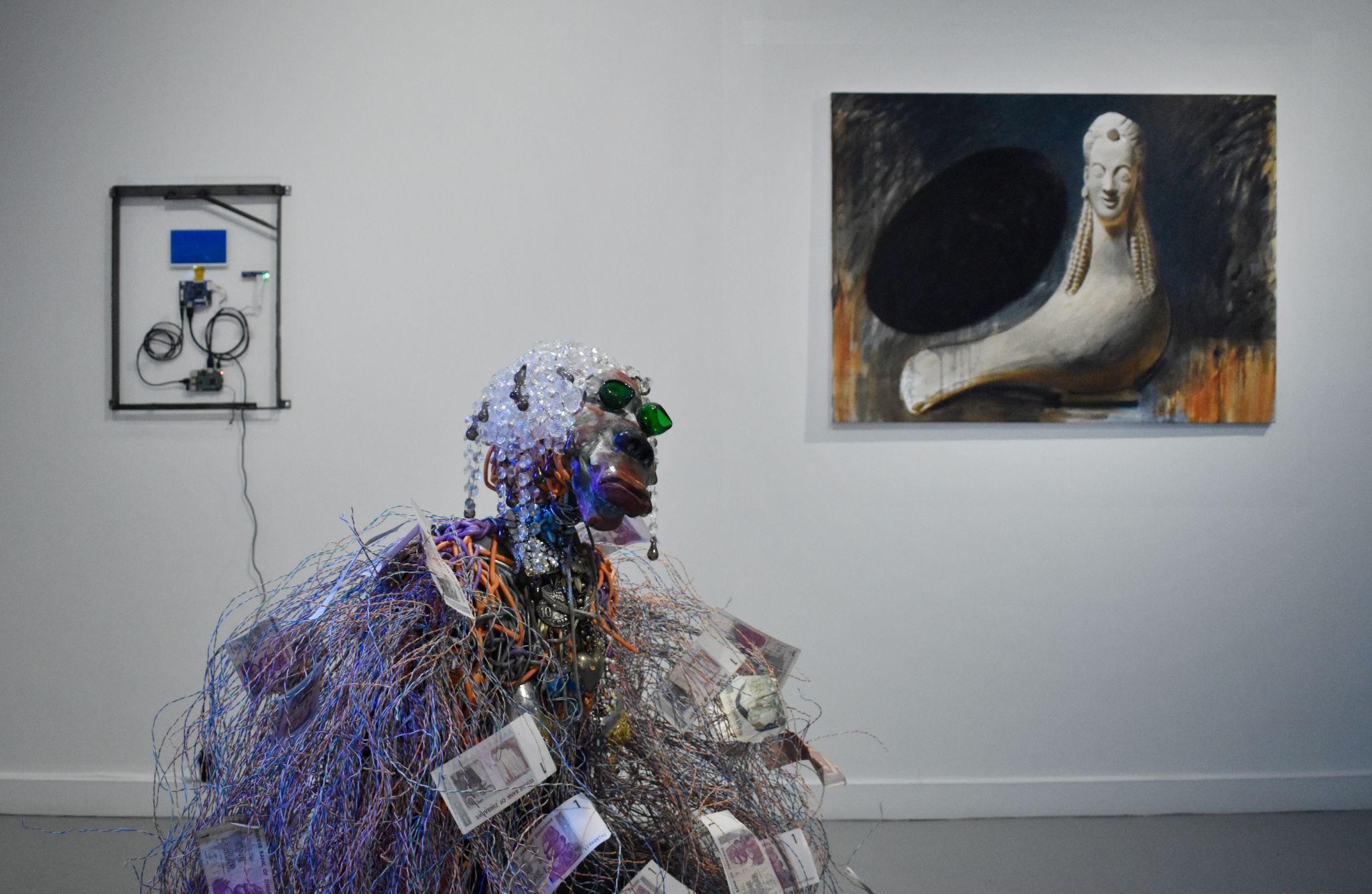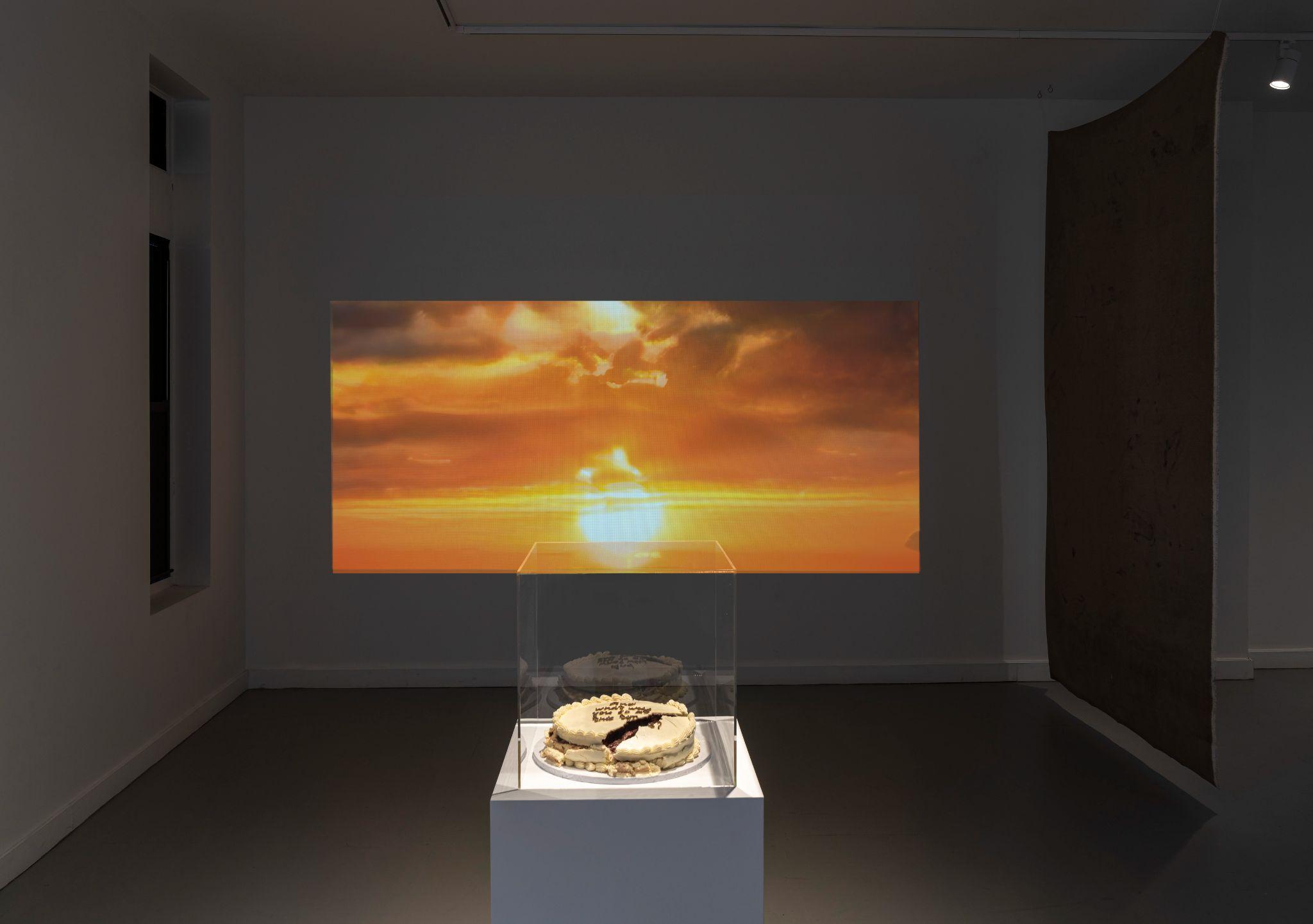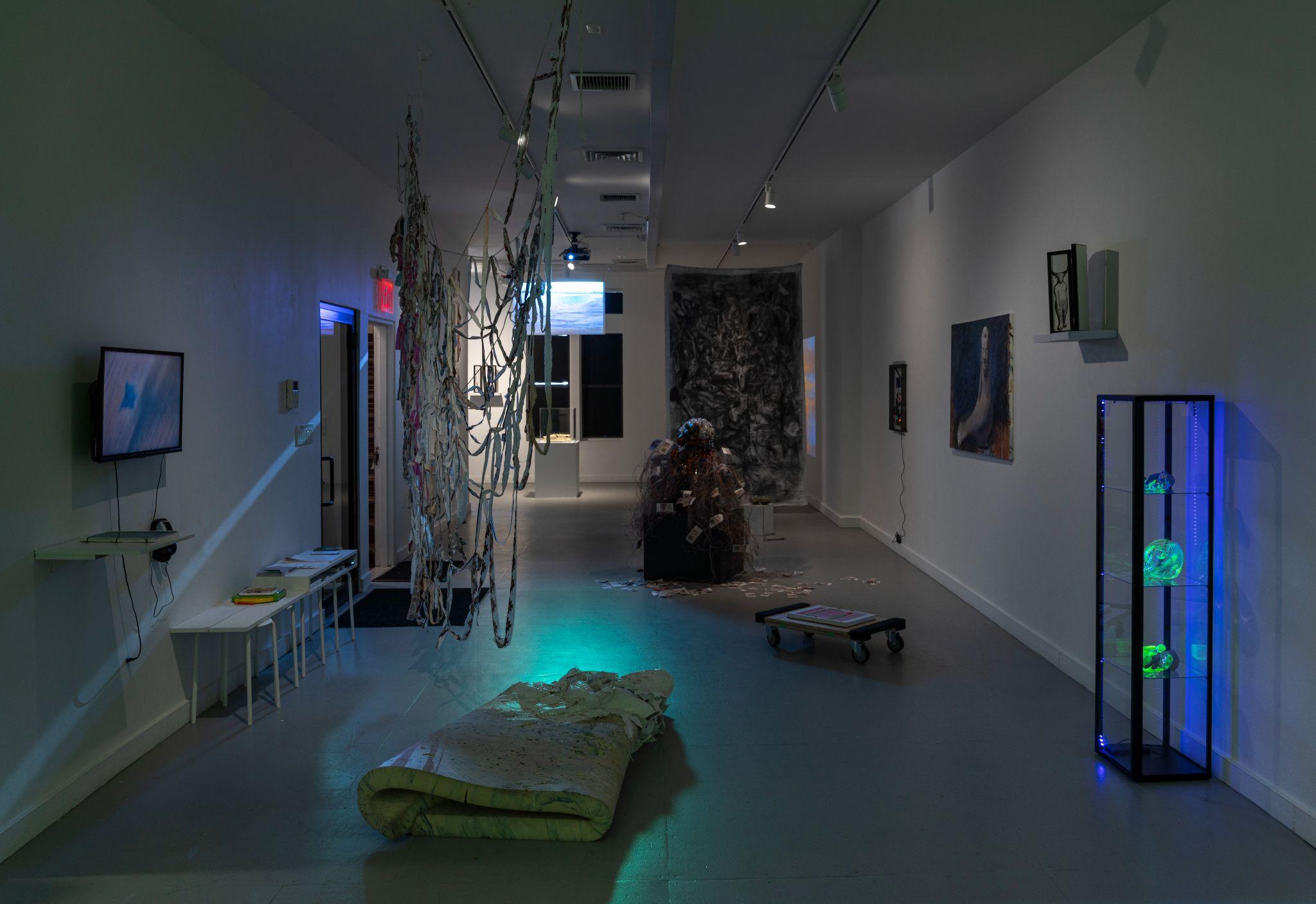At NADA an Exhibition on Ukraine’s State of Emergency Unfolds


Incongruity theory, as championed by Emmanuel Kant, denotes laughter as a response to incongruity—i.e. ambiguity, logical impossibility, irrelevance, and inappropriateness. Laughter related to the Russo-Ukrainian war falls within this category, and is, according to the Ukrainian artist Slinko, awkward but very important. Her work is currently on view in “State of Emergence” an exhibition featuring twenty mostly Ukrainian and Ukrainian diaspora artists at NADA’s gallery on East Broadway.
At a talk in the gallery, Slinko presented her theory on humor and laughter and how it relates to the war—Vladimir Putin wants to suffocate it, while the West welcomes it as an important geopolitical tool to humiliate. On a personal level, Slinko started making satirical drawings when she lost touch with her family in Bakhmut; trying to delineate appropriate with inappropriate, merging humor with terror.
“Oppressive regimes cannot accept jokes-” she explains, continuing “-remember that according to Orwell all jokes are small revolutions.” Her well-written and rehearsed lecture covered much ground art history, literary, psychology, and current affairs. Slinko’s family hails from Bakhmut and her childhood home has been razed to the ground, it is clear she is trying to make sense of the senseless. As the West endlessly is out to humiliate Russia, the Kremlin is fundamentally afraid of laughter and their propaganda machine is relentless, at times ridiculous. Grasping at all straws, the Russian Orthodox Church blesses missiles before they are launched. The talk takes place on Maidan’s 10-year anniversary and Slinko, who works predominantly in video, shows us snippets from projects where she has interviewed Ukrainians about Soviet monuments, from 2013, and the invasion of Crimea, in 2014.

The situation is devastating, senseless, and urgent as the curators Lesia Kluchynska and Catinca Tabacaru imply in their title which is a pun on ‘state of emergency.’ Taking the war in Ukraine as a point of departure, the exhibition—that is the third in a series—-begs viewers to think about “coexistence on this endangered planet we share.” Presiding over the space, installed above head on the left of the entrance, is Lesia Vasylchenko’s “Tachyoness,” a poetic call for the end of the war. The eight-minute video of AI-generated sunsets based on Ukraine at once posits the sun rising tomorrow, but also, evoking a ‘tachyon’, a hypothetical particle that travels faster than light, This idea of time and cyclicality is present in many works. Katia Lesiv’s work “And what will you do at this time?” is simply a half. eaten cake with its title in cursive legible on the top, it will rot and decompose during the run of the exhibition—because as we know, you cannot have your cake and eat it too.
War means death, both consenting and unconsenting. Soldiers active in combat, for instance, run a much higher risk of being killed or dying. An installation presenting print publications from 2020-23 from the Association for Palliative Turn brings the conversation of death and consent into a non-militaristic context—at once alluding to the fact that death per se, is not always bad, but war certainly is.
Not all artists are Ukrainian, curators place colonization and genocide as a ‘state of emergency’ that is currently taking place, or which history still plagues people, from other locations, Terrence Musekiwa, who is from Harare, Zimbabwe, transcends colonial legacies in the mixed media sculpture “Muunzi tsika yepakutanga” that incorporates objects of resistance—a 1970s riot helmut and internet cables—with precious natural resources spring stone, red jasper, and butter jade stone, to represent the roots of colonial trade.

Exploring false promises of safety and normalcy at the time of “war at home”, Katya Grokhovsky’s “Run for Cover” is a found object sculpture fiber installation, which proposes a brief illusion of a healing space— featuring deconstructed bedding and a mattress. For Maria Kulikovska she cannot return “home” as she is now considered an Internally Displaced Person (IDP) being from Crimea which was annexed in 2014. It is impossible to cross the border from Ukraine and dangerous for those who are pro-Ukrainian to be there. Kulikovska has since 2014 used watercolor drawings to process the fear, stress, and emotions related to her migration. In the series on view at NADA she paints body parts on papers from Migration offices.
With funding from Ukrainian Institute “State of Emergence” is also a call for attention. Many of the artists included are exhibiting and speaking across the U.S. and Europe within war-related contexts. Kulikovska has resided in residencies in Linz, Helsinki, and now London with a solo show titled “My Body is a Battlefield” at the Museum of Linz and concurrently with “State of Emergence” Her work is included in The Immigrant Artist Biennial’s Central Exhibition “Conflictual Distance” at EFA Project Space. I first heard her speak at a talk in spring 2022 organized by Joanna Warsza titled: “Let the women end the war” where Kulikoska together with Lizaveta German, the Ukrainian Pavilion at the Venice Biennial’s co-curator, both new mothers at the time, spoke about how the war will regress gender equity in Ukrainian society. Around that same time, Grokhovsky co-organized a series of talks at Brooklyn Rail titled Ukrainians on Ukraine.
While other artists have built up careers outside of Ukraine. Such as Vasylchenko, who is based in Oslo and a fixture in the art world there as an artist but also co-curator of the artist-run gallery space Podium and founder of STRUKTURA, a cross-disciplinary research project about time. Vasylchenko and many other Ukrainian are receiving deserved attention, but acceptance is tainted by the war. The exhibition title’s double entendre is not lost; the war has fostered an emergence on the art scene for Ukrainian artists. Importantly, among a multitude of necessary Ukrainian exhibitions and programming “State of Emergence” brings the war into a wider perspective by showcasing artists from multiple nationalities while igniting questions about death, time, and tools to cope, like humor and self-care, which are much needed in this dire situation.
State of Emergence is on view through December 10, 2023 at NADA on 311 East Broadway, 10002, NY, NY.
You Might Also Like
State of Becoming: Katya Grokhovsky in Conversation with Leeza Meksin at Ortega y Gasset Projects
What's Your Reaction?
Anna Mikaela Ekstrand is editor-in-chief and founder of Cultbytes. She mediates art through writing, curating, and lecturing. Her latest books are Assuming Asymmetries: Conversations on Curating Public Art Projects of the 1980s and 1990s and Curating Beyond the Mainstream. Send your inquiries, tips, and pitches to info@cultbytes.com.

